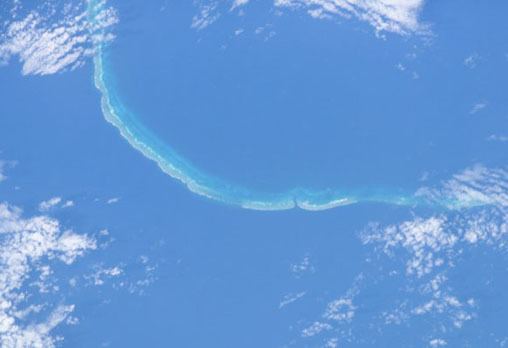Name HMS Zenobia Out of service 6 August 1835 Tons burthen 384 ⁄94 (bm) | Fate Broken up Launched 7 October 1807 | |
 | ||
Class and type 18-gun Cruizer-class brig-sloop | ||
HMS Zenobia was an 18-gun Cruizer-class brig-sloop launched 7 October 1807 by Brindley at King’s Lynn. Although she served during the Napoleonic Wars she is known for her role in two events, the claiming of Ascension Island for Great Britain in 1815, and the naming of the Saumarez Reefs in 1823. She was broken up in 1835.
Contents
Napoleonic Wars and War of 1812
Commander Alexander K. Mackenzie commissioned her and remained her captain until July 1812. During that time she was in the North Sea and visited Portugal at least twice.
Zenobia was one of the Royal Navy vessels involved in the ill-fated Walcheren Campaign, which started on 30 July 1809. In August she was part of the light squadron under Sir Edward Owen and participated in the bombardment of Flushing. British forces withdrew in December. On 26 November Zenobia captured the Danish Ship Twee Gebroeders.
In early January 1810 Zenobia sent Emanuel, Findrup, master, of Christiana, into Yarmouth.
On 18 September 1810 she joined Venerable in the chase and capture of Alexander, a French ketch privateer of 16 guns (but only four mounted). Alexander was on her first cruise out of Saint-Malo and had captured the schooner Peggy. On 24 October Zenobia sailed for Portugal.
Zenobia sailed for Portugal on 24 January 1812, and in July Commander Richard Foley assumed command. The next month Zenobia captured the American ships Cordelia, Salter, master (14 August), Catherine, Allen, master, (17 August) and America, Hilbert, master (24 August). Cordelia, of St. Ubes, arrived in Lisbon on 19 August. Catherine, of St Michaels, arrived there on 23 August. America had been sailing from Baltimore to Lisbon and arrived at Plymouth on 8 September. Cordelia reached Plymouth on 19 September. Catherine arrived at Plymouth on 2 October. The London Gazette report of a grant of two-thirds of the value of the detained vessels states that the detainment took place prior to hostilities.
In December, Zenobia detained and sent into Gibraltar George and Albert, Dashiel, master. George and Albert had been sailing from Baltimore to Gibraltar.
In late January or early February 1813, Zenobia captured Little James, which was sailing from Lisbon to America. However, the American privateer Paul Jones, of 16 guns and 120 men, recaptured Little James. She was only one of a number of vessels that Paul Jones captured at around this time. However, the gun-brig Rebuff recaptured James (aka Little James), May, master, and sent her into Gibraltar in February.
On 25 June 1813 Zenobia captured the American ship Hindostan. The initial payment of prize money amounted to ₤5000. Two days later Zenobia captured Isabella. Isabella, Shepheard, master, had been sailing from New Orleans to Cadiz.
At about the same time Zenobia detained Hepsa, Bailey, master, which had been sailing from New York to Lisbon.
On 3 January 1814 Zenobia captured Wellington.
On 7 June Foley received promotion to post-captain and Commander Nicholas Charles Dobree assumed command.
Under Dobree, Zenobia recaptured William & Alfred on 5 January 1815 and Diana on 3 March. The American privateer Harpy had captured William & Alfred off Cape Finisterre three days before as she was sailing from London to Antigua. Zenobia sent her into Lisbon on 10 January, minus part of the cargo, which Harpy had taken. The privateer James Munro had captured Diana, of Greenock, Ferguson, master. diana had been sailing from Alicante to Londonderry when James Munro captured her. After Zenobia had recaptured Diana, Zenobia took Diana into Lisbon.
Ascension Island
Zenobia, under Commander Nicholas Charles Dobree, together with her sister ship Peruvian, under Captain James Kearney White, had been part of the flotilla under Rear Admiral George Cockburn that had taken Napoleon into his final exile at St Helena. Cockburn was concerned that the French might use Ascension Island, uninhabited at the time, to stage a rescue mission. He therefore decided to claim and garrison the island. On 22 October 1815, at 5pm, Zenobia and Peruvian anchored in Clarence Bay. The ships' logs record that at 5.30pm, Dobree and White came ashore, raised the Jack, and took possession of the island in the name of His Britannic Majesty, King George III. Zenobia left shortly thereafter, while Peruvian stayed until Spring. On 8 April 1816 Zenobia arrived in Plymouth and was laid up.
Napoleon died on St Helena in 1821 and the Admiralty wanted to withdraw the garrison. However, Sir George Collier, Commodore of the West Africa Squadron, persuaded the Admiralty to retain it as it had become a victualing station for the vessels of the squadron, which was engaged in anti-slavery patrols. It also provided a sanatorium for the squadron's ships and crew. The Admiralty later designated Ascension Island "HMS Ascension", a "Stone sloop of War of the smaller class".
Saumarez Reefs
Lieutenant John Lihou, then Master of Zenobia, was on passage from Manila to South America and had chosen a route through Torres Strait. This was the first occasion a ship had navigated the Torres Strait from west to east. It was also the first occasion a ship traversed the Coral Sea from Torres Strait, south-eastward to the southward of New Caledonia. Lihou saw Sir James Saumarez' Shoal (now Saumarez Reefs) on 27 February 1823, and named the reef system after Vice-Admiral James Saumarez. On this same trip, Lihou discovered the Lihou Reef and Cays and Port Lihou. Zenobia left Sydney, New South Wales, in April.
Fate
On 6 August 1835 the Navy Office offered Zenobia for sale by Dutch auction for £1600 but had to take her in at £890. Later that month a Mr. Tibbett bought her for £650 for breaking up.
